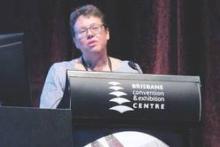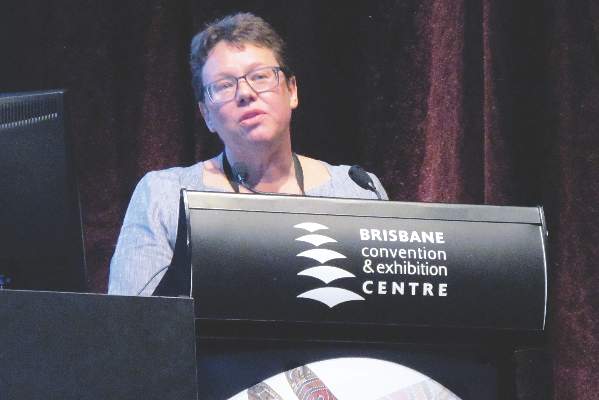User login
BRISBANE, AUSTRALIA – A 3-year randomized, controlled trial of annual chlamydia screening in 16- to 29-year-olds has shown that despite a significant increase in testing rates and diagnoses, screening did not achieve a significant reduction in prevalence when compared with the control group.
Preliminary Australian trial results, presented at the World STI & HIV Congress 2015, showed the rates of testing in the intervention arm increased from around 8% at recruitment to nearly 19% at 3 years, compared with 12% in the control group.
However, there was a nonsignificant 5% difference in the estimated treatment effect between the intervention group and the control group after 3 years.
The Australian Chlamydia Control Effectiveness Pilot (ACCEPt) was a cluster randomized trial, where each unit of randomization contained all the general practice or Aboriginal health clinics within an entire town or rural area.
Jane S. Hocking, Ph.D., the lead researcher, told conference attendees that this approach was taken to minimize the risk of contamination between intervention and control arms, as Australians can switch their primary care physicians at any time.
“One of the most encouraging things that we found was of all the clinics we approached, over 90% agreed to participate, which was a staggeringly high uptake rate,” said Dr. Hocking of the Melbourne School of Population and Global Health at the University of Melbourne.
From 52 areas, the study recruited 66 clinics in the intervention arm and 67 in the control arm, representing a population of around 65,000 individuals in the 16- to 29-year-old age bracket.
Clinic staff in the intervention arm were encouraged and assisted in providing annual chlamydia testing for their 16- to 29-year-old patients, while control clinics were asked to continue with their usual practices.
Chlamydia prevalence was recorded at baseline and 3 years via recruitment and testing of every 16- to 29-year-old who entered each clinic over a period of 3-4 weeks. At baseline, the prevalence of chlamydia was 5.1% in the intervention group and 4.5% in the control group, which dropped to 3.6% and 3.3% respectively after 3 years; however, the difference in the estimated treatment effect between the two groups failed to achieve statistical significance.
But there were some surprises in the findings, Dr. Hocking said, such as a fairly large drop in overall prevalence.
“Our estimated prevalence dropped overall by nearly 30% and we [have] yet to figure out why; we had the same response rate between surveys, same methodology, similar age, and sexual behavior profile in both surveys, so we’re going to see if it’s the consequence of other activities occurring,” she said.
Dr. Hocking told the conference that data on cost-effectiveness and the impact of the intervention on pelvic inflammatory disease hospitalizations were not yet available.
“What we have demonstrated is that chlamydia screening is acceptable and feasible in general practice, and the 90% participation among clinics and 70% participation among patients in the surveys are evidence of this,” Dr. Hocking said.
Dr. Nicola Low, a coinvestigator on the ACCEPt study, said that randomized, controlled trials like this one are challenging to conduct.
“They don’t always come out with expected results, so we’re faced with the challenge of how to interpret these results,” said Dr. Low of the Institute of Social and Preventive Medicine at the University of Bern, Switzerland.
The intervention may have failed to have an impact because the testing rates were not high enough or because the intervention did not continue for long enough, Dr. Hocking said in an interview.
“The modeling suggests that if you get the testing up over 30% for several years, you should see a reduction,” she said.
The trial was supported by Australian Federal and State government health departments and by the National Health and Medical Research Council. The researchers reported having no financial disclosures.
BRISBANE, AUSTRALIA – A 3-year randomized, controlled trial of annual chlamydia screening in 16- to 29-year-olds has shown that despite a significant increase in testing rates and diagnoses, screening did not achieve a significant reduction in prevalence when compared with the control group.
Preliminary Australian trial results, presented at the World STI & HIV Congress 2015, showed the rates of testing in the intervention arm increased from around 8% at recruitment to nearly 19% at 3 years, compared with 12% in the control group.
However, there was a nonsignificant 5% difference in the estimated treatment effect between the intervention group and the control group after 3 years.
The Australian Chlamydia Control Effectiveness Pilot (ACCEPt) was a cluster randomized trial, where each unit of randomization contained all the general practice or Aboriginal health clinics within an entire town or rural area.
Jane S. Hocking, Ph.D., the lead researcher, told conference attendees that this approach was taken to minimize the risk of contamination between intervention and control arms, as Australians can switch their primary care physicians at any time.
“One of the most encouraging things that we found was of all the clinics we approached, over 90% agreed to participate, which was a staggeringly high uptake rate,” said Dr. Hocking of the Melbourne School of Population and Global Health at the University of Melbourne.
From 52 areas, the study recruited 66 clinics in the intervention arm and 67 in the control arm, representing a population of around 65,000 individuals in the 16- to 29-year-old age bracket.
Clinic staff in the intervention arm were encouraged and assisted in providing annual chlamydia testing for their 16- to 29-year-old patients, while control clinics were asked to continue with their usual practices.
Chlamydia prevalence was recorded at baseline and 3 years via recruitment and testing of every 16- to 29-year-old who entered each clinic over a period of 3-4 weeks. At baseline, the prevalence of chlamydia was 5.1% in the intervention group and 4.5% in the control group, which dropped to 3.6% and 3.3% respectively after 3 years; however, the difference in the estimated treatment effect between the two groups failed to achieve statistical significance.
But there were some surprises in the findings, Dr. Hocking said, such as a fairly large drop in overall prevalence.
“Our estimated prevalence dropped overall by nearly 30% and we [have] yet to figure out why; we had the same response rate between surveys, same methodology, similar age, and sexual behavior profile in both surveys, so we’re going to see if it’s the consequence of other activities occurring,” she said.
Dr. Hocking told the conference that data on cost-effectiveness and the impact of the intervention on pelvic inflammatory disease hospitalizations were not yet available.
“What we have demonstrated is that chlamydia screening is acceptable and feasible in general practice, and the 90% participation among clinics and 70% participation among patients in the surveys are evidence of this,” Dr. Hocking said.
Dr. Nicola Low, a coinvestigator on the ACCEPt study, said that randomized, controlled trials like this one are challenging to conduct.
“They don’t always come out with expected results, so we’re faced with the challenge of how to interpret these results,” said Dr. Low of the Institute of Social and Preventive Medicine at the University of Bern, Switzerland.
The intervention may have failed to have an impact because the testing rates were not high enough or because the intervention did not continue for long enough, Dr. Hocking said in an interview.
“The modeling suggests that if you get the testing up over 30% for several years, you should see a reduction,” she said.
The trial was supported by Australian Federal and State government health departments and by the National Health and Medical Research Council. The researchers reported having no financial disclosures.
BRISBANE, AUSTRALIA – A 3-year randomized, controlled trial of annual chlamydia screening in 16- to 29-year-olds has shown that despite a significant increase in testing rates and diagnoses, screening did not achieve a significant reduction in prevalence when compared with the control group.
Preliminary Australian trial results, presented at the World STI & HIV Congress 2015, showed the rates of testing in the intervention arm increased from around 8% at recruitment to nearly 19% at 3 years, compared with 12% in the control group.
However, there was a nonsignificant 5% difference in the estimated treatment effect between the intervention group and the control group after 3 years.
The Australian Chlamydia Control Effectiveness Pilot (ACCEPt) was a cluster randomized trial, where each unit of randomization contained all the general practice or Aboriginal health clinics within an entire town or rural area.
Jane S. Hocking, Ph.D., the lead researcher, told conference attendees that this approach was taken to minimize the risk of contamination between intervention and control arms, as Australians can switch their primary care physicians at any time.
“One of the most encouraging things that we found was of all the clinics we approached, over 90% agreed to participate, which was a staggeringly high uptake rate,” said Dr. Hocking of the Melbourne School of Population and Global Health at the University of Melbourne.
From 52 areas, the study recruited 66 clinics in the intervention arm and 67 in the control arm, representing a population of around 65,000 individuals in the 16- to 29-year-old age bracket.
Clinic staff in the intervention arm were encouraged and assisted in providing annual chlamydia testing for their 16- to 29-year-old patients, while control clinics were asked to continue with their usual practices.
Chlamydia prevalence was recorded at baseline and 3 years via recruitment and testing of every 16- to 29-year-old who entered each clinic over a period of 3-4 weeks. At baseline, the prevalence of chlamydia was 5.1% in the intervention group and 4.5% in the control group, which dropped to 3.6% and 3.3% respectively after 3 years; however, the difference in the estimated treatment effect between the two groups failed to achieve statistical significance.
But there were some surprises in the findings, Dr. Hocking said, such as a fairly large drop in overall prevalence.
“Our estimated prevalence dropped overall by nearly 30% and we [have] yet to figure out why; we had the same response rate between surveys, same methodology, similar age, and sexual behavior profile in both surveys, so we’re going to see if it’s the consequence of other activities occurring,” she said.
Dr. Hocking told the conference that data on cost-effectiveness and the impact of the intervention on pelvic inflammatory disease hospitalizations were not yet available.
“What we have demonstrated is that chlamydia screening is acceptable and feasible in general practice, and the 90% participation among clinics and 70% participation among patients in the surveys are evidence of this,” Dr. Hocking said.
Dr. Nicola Low, a coinvestigator on the ACCEPt study, said that randomized, controlled trials like this one are challenging to conduct.
“They don’t always come out with expected results, so we’re faced with the challenge of how to interpret these results,” said Dr. Low of the Institute of Social and Preventive Medicine at the University of Bern, Switzerland.
The intervention may have failed to have an impact because the testing rates were not high enough or because the intervention did not continue for long enough, Dr. Hocking said in an interview.
“The modeling suggests that if you get the testing up over 30% for several years, you should see a reduction,” she said.
The trial was supported by Australian Federal and State government health departments and by the National Health and Medical Research Council. The researchers reported having no financial disclosures.
FROM THE WORLD STI & HIV CONGRESS 2015
Key clinical point:A 3-year randomized, controlled trial of annual chlamydia screening in 16- to 29-year-olds has failed to achieve a significant reduction in disease prevalence.
Major finding: A randomized, controlled trial of annual chlamydia screening has achieved a nonsignificant 5% difference in estimated treatment effect between the intervention group and controls.
Data source: Randomized controlled cluster trial in 52 rural towns and regions in Australia.
Disclosures: The trial was supported by Australian Federal and State government health departments and by the National Health and Medical Research Council. The researchers reported having no financial disclosures.

